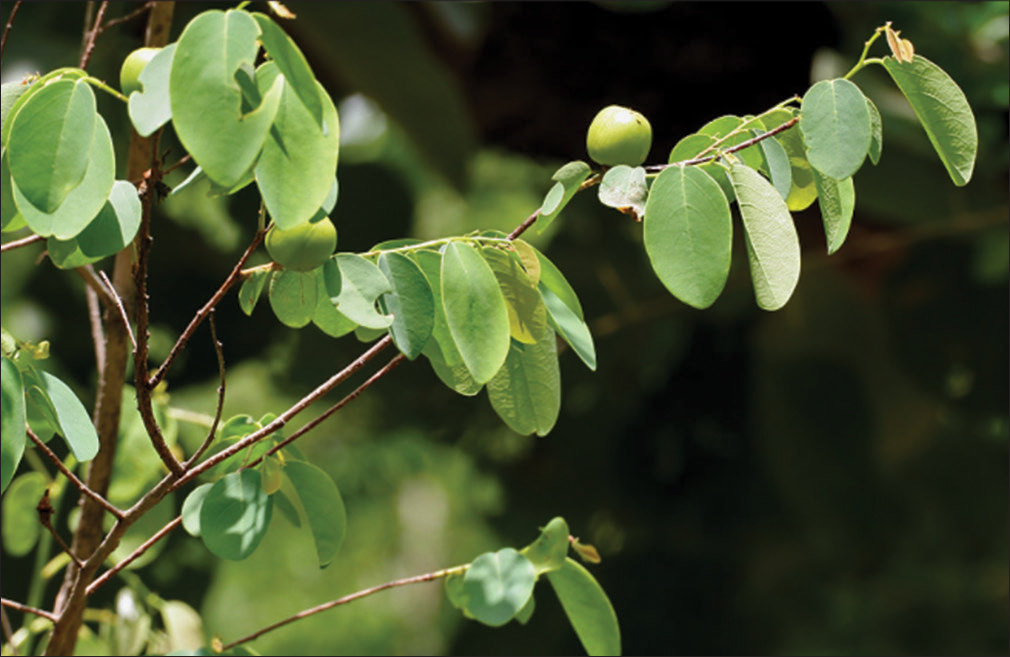Translate this page into:
“Self-Harming the Tubules” – A Rare Case of Renal Tubular Acidosis
Corresponding Author: Dr. Arun K. Anandan, Assistant Professor, Department of Nephrology, Govt Medical College, Ernakulam - 683 503, Kerala, India. E-mail: drarunkarat@gmail.com
-
Received: ,
Accepted: ,
How to cite this article: Anandan AK, Sasikumar S. “Self-Harming the Tubules” – A Rare Case of Renal Tubular Acidosis. Indian J Nephrol 2024;34:96-7. doi: 10.4103/ijn.ijn_128_23
Dear Editor,
Renal toxicity due to consumption of herbal preparations results from organic acids, alkaloids, lactones, toxic proteins, glycosides, and saponins.1 We present a case of poisoning with Cleisanthus collinus, complicated by transient distal renal tubular acidosis (dRTA).
A 65-year-old lady consumed C. collinus leaves mixed with Abrus precatorius seeds 2 days back to commit suicide and presented with multiple episodes of vomiting and severe fatigue. On examination, she was conscious, oriented, and had stable vitals. She was found to have motor weakness (power grade 3–4). Intravenous normal saline, proton pump inhibitors, and antiemetics were started. Blood reports showed severe hypokalemia (serum K- 2.1 meq/l). Possibility of metabolic alkalosis secondary to vomiting was considered. She was started on potassium chloride supplementation. Surprisingly, arterial blood gas analysis showed metabolic acidosis with normal anion gap. Subsequent investigation showed a positive urine anion gap. At this time, dRTA as a complication of C. collinus poisoning was considered. Sodium bicarbonate was added to her treatment regimen. She gradually improved symptomatically. Repeat tests showed improvement in hypokalemia and metabolic acidosis. Follow-up reports after discharge showed normal K and arterial blood gas analysis [Table 1].
| Arterial blood gas on admission | At discharge | 1 month after discharge | 3 months after discharge | |
|---|---|---|---|---|
| pH- 7.12 | Serum K- 3.5 meq/L | Serum K- 4.1 meq/l | Serum K- 3.9 meq/l | |
| pCO2-25 mmHg | Blood pH- 7.36 | Blood pH- 7.39 | Blood pH- 7.42 | |
| HCO3-11.5 mmol/dl | pCO2-38 mmHg | pCO2-41 mmHg | pCO2-37 mmHg | |
| pO2-150 mmHg | HCO3-23 mmol/dl | HCO3-25.6 mmol/dl | HCO3-24.3 mmol/dl | |
| Chloride- 119 mmol/dl | pO2-135 mmHg | pO2-180 mmHg | pO2-123 mmHg | |
| sO2-99% | Chloride- 101 mmol/dl | Chloride- 97 mmol/dl | Chloride-103 mmol/dl | |
| Anion gap- 9.5 | ||||
| Urine anion gap- positive | ||||
C. collinus poisoning is associated with 40% mortality.2 This toxic shrub belongs to the family Euphorbiaceae. It is known by regional names like Garari, Vadisaaku, Oduvanthalai, Odakku, and so on [Figure 1]. The toxicity has been primarily attributed to the lactones cleisanthin A and B.3

- Cleisanthus collinus plant.
In rat models, the toxins produced severe metabolic acidosis, hypokalemia, and persistent alkaline urine.4 The inhibition of vacuolar H+-ATPase in the renal tubular brush boarder can explain the mechanism of dRTA.5 Rarely, proximal tubular or generalized tubular dysfunction and reduced glomerular filtration rate (GFR) have been reported.2 Other manifestations of this plant poisoning include neuromuscular blockade, type 2 respiratory failure, acute respiratory distress syndrome, and cardiac arrhythmias.2
Declaration of patient consent
The authors certify that they have obtained all appropriate patient consent forms.
Conflicts of interest
There are no conflicts of interest.
Financial support and sponsorship
Nil.
References
- Nephrotoxicity of herbal medicine and its prevention. Front Pharmacol. 2020;11:569551. doi: 10.3389/fphar.2020.569551
- [CrossRef] [PubMed] [Google Scholar]
- Cleistanthus collinus poisoning. J Emerg Trauma Shock. 2012;5:160-6.
- [CrossRef] [PubMed] [Google Scholar]
- Arylnaphthalide lignans from Cleistanthus collinus. Chem Pharm Bull (Tokyo). 2003;51:1299-300.
- [CrossRef] [PubMed] [Google Scholar]
- Cleistanthus collinus induces type I distal renal tubular acidosis and type II respiratory failure in rats. Indian J Pharmacol. 2010;42:178-84.
- [CrossRef] [PubMed] [Google Scholar]
- Mechanisms of toxicity of Cleistanthus collinus: vacuolar ATPases are a putative target. Clin Toxicol (Phila). 2011;49:457-63.
- [CrossRef] [PubMed] [Google Scholar]






